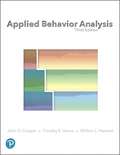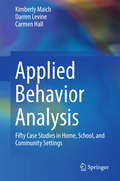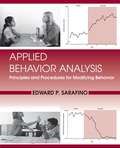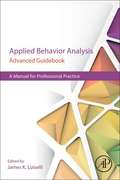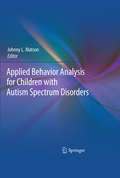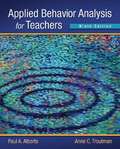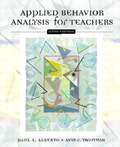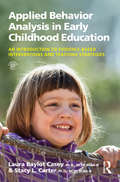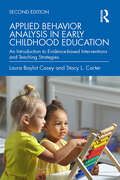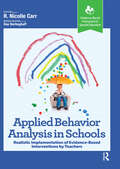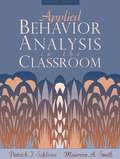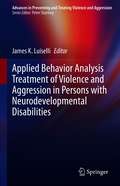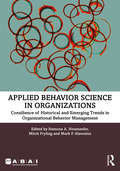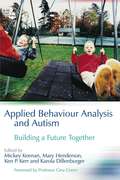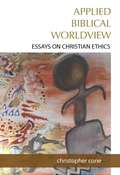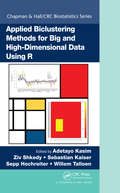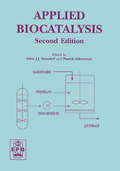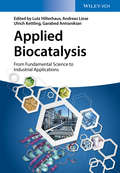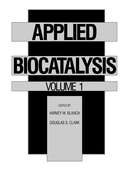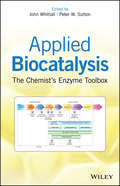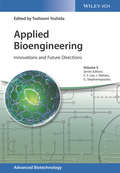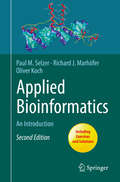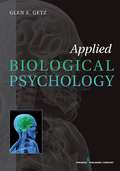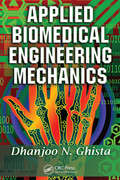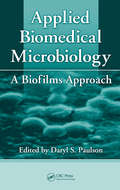- Table View
- List View
Applied Behavior Analysis
by John O. Cooper Timothy E. Heron William L. HewardThis text provides an accurate, comprehensive, and contemporary description of applied behavior analysis in order to help readers acquire fundamental knowledge and skills. Applied Behavior Analysis provides a comprehensive, in-depth discussion of the field, offering a complete description of the principles and procedures for changing and analyzing socially important behavior. The 3rd Edition features coverage of advances in all three interrelated domains of the sciences of behavior–theoretical, basic research, and applied research–and two new chapters, Equivalence-based Instruction (Ch. 19) and Engineering Emergent Learning with Nonequivalence Relations (Ch. 20). It also includes updated and new content on topics such as negative reinforcement (Ch. 12), motivation (Ch. 16), verbal behavior (Ch. 18), functional behavioral assessment (Ch. 27), and ethics (Ch. 31).
Applied Behavior Analysis: Fifty Case Studies in Home, School, and Community Settings
by Darren Levine Kimberly Maich Carmen HallThis textbook offers real-world case studies for using Applied Behavior Analysis (ABA) to create, implement, and appraise behavior intervention programs across a variety of client situations. Its chapters are formatted for ease of use and retention and organized to focus on the core components of ABA: assessment, planning, implementation, evaluation, and research/ethics. Illustrative cases represent a diversity of problem behaviors, settings, social contexts, and life stages, and includes questions about data collection, goal setting, communication with families, and other processes of effective ABA practice. Together they emphasize not only the content knowledge involved in designing interventions, but also the interpersonal skills necessary for helping change complex challenging behaviors. These fifty case studies: Are suited to individual or team training. Present guiding questions regarding ABA process and professional practice. Feature charts, forms, templates, and other practical tools. Include links to Behavior Analyst Certification Board resources. Demonstrate the flexibility of ABA for use with children, adolescents, adults, or seniors. Applied Behavior Analysis: Fifty Case Studies in Home, School, and Community Settings is an essential text for graduate students, researchers, and practitioners in child and school psychology, behavior analysis, learning and instruction, counseling, and education. This singular volume models critical thinking and professional development in keeping with best practices and professional standards.
Applied Behavior Analysis: Principles and Procedures for Modifying Behavior
by Edward P. SarafinoSarafino's goal in Principles and Procedures for Modifying Behavior is to create a clear and engaging instrument that describes ways to analyze one's own specific behaviors in terms of the factors that lead to and maintain them and ways to manage those factors to improve the behaviors. The text is based on research, theory, and experiences to explain and provide examples of the concepts and methods of self-management in a comprehensive text. It focuses on topics in applied behavior analysis, behavior modification, behavior therapy, and psychology of learning. Two general topics shaped this text: making the book relative to a variety of fields by describing applications in psychology, education, counseling, nursing, and physical therapy and different academic levels and preparation. Several important objectives guided the content and organization of the text which is designed to cover a large majority of tasks or concepts that the Behavior Analyst Certification Board (www. bacb. com) has identified as the field's essential content and should be mastered by all behavior analysts.
Applied Behavior Analysis Advanced Guidebook: A Manual for Professional Practice
by James K. LuiselliThe Applied Behavior Analysis Practice Guidebook: A Manual for Professional Practice gives behavioral practitioners pragmatic advice, direction and recommendations for being an effective clinician, consultant, supervisor and performance manager. The book adopts a how to do it perspective featuring contributions from expert scientist-practitioners. Each chapter introduces the relevance of the topic for practicing professionals, describes and synthesizes the empirical basis of the topic, and then presents practitioner recommendations. With this format, readers can navigate the chapters with familiarity and confidence to facilitate the understanding of content and integration of the many practice areas addressed.
Applied Behavior Analysis for Children with Autism Spectrum Disorders
by Johnny L. MatsonAutism was once thought of as a rare condition, until the Centers for Disease Control and Prevention's Autism and Developmental Disabilities Monitoring Network released the statistic that about 1 in every 150 eight-year-old children in various areas across the United States is afflicted by an autism spectrum disorder, or ASD. This news led to a dramatic expansion of research into autism spectrum disorders and to the emergence of applied behavior analysis (ABA) as the preferred method of treatment, even among prescribing practitioners. Applied Behavioral Analysis for Children with Autism Spectrum Disorders ably synthesizes research data and trends with best-practice interventions into a comprehensive, state-of-the-art resource. Within its chapters, leading experts review current ABA literature in depth; identify interventions most relevant to children across the autism spectrum; and discuss potential developments in these core areas: Assessment methods, from functional assessment to single case research designs. Treatment methods, including reinforcement, replacement behaviors, and other effective strategies. The role of the differential diagnosis in ABA treatment planning. Specific deficit areas: communication, social skills, stereotypies/rituals. Target behaviors, such as self-injury, aggression, adaptive and self-help problems. ASD-related training concerns, including maintenance and transition issues, and parent training programs. This volume is a vital resource for researchers, graduate students, and professionals in clinical child and school psychology as well as the related fields of education and mental health.
Applied Behavior Analysis for Teachers
by Paul A. Alberto Anne C. TroutmanThe market-leading book Applied Behavior Analysis for Teachers gives you what you need to understand to use the principles and practices of applied behavior analysis in the classroom. The content is presented clearly, in a friendly, accessible-even fun-manner. The ninth edition uses classroom-based examples and practices firmly grounded in research. Content is presented in the order of decision-making by a teacher who has a student exhibiting challenging behavior in class or a student who needs to execute a behavior-change project. The text covers identifying target behavior, collecting and graphing data, functional assessment, experimental design, arranging antecedents and consequences, and generalizing behavior change. The importance of ethical considerations in using applied behavior analysis in the classroom is now presented at the beginning of the book to highlight the importance of applying principles and practices responsibly.
Applied Behavior Analysis for Teachers
by Paul A. Alberto Anne C. TroutmanThis text explains behavior theory and teaches aspiring educators how to apply it to classroom settings.
Applied Behavior Analysis in Early Childhood Education: An Introduction to Evidence-based Interventions and Teaching Strategies
by Laura Baylot Casey Stacy L. CarterApplied Behavior Analysis in Early Childhood Education provides a basic introduction to applied behavior analysis and the highly beneficial role that it can play in early childhood education for both typically developing children and those with special needs. The objective is to provide future and current early childhood professionals with the tools that they need to positively impact the lives of young children. Specifically, the book will describe and provide useful examples related to the following: Implementing effective techniques for changing behavior; Strategies for every day challenges both in the classroom and at home; Strategies for addressing less frequent issues; Suggestions for how to consult and correspond with parents and caretakers. Applied Behavior Analysis in Early Childhood Education is written for professionals preparing for—or those already in—careers in child development, behavior analysis, early childhood education, developmental therapy, counseling, special education, and other helping professions. A Companion Website featuring additional information and resources for students and instructors can be accessed at www.routledge.com/cw/casey.
Applied Behavior Analysis in Early Childhood Education: An Introduction to Evidence-based Interventions and Teaching Strategies
by Laura Baylot Casey Stacy L. CarterApplied Behavior Analysis in Early Childhood Education provides a basic introduction to applied behavior analysis and overviews the highly beneficial role that it can play in early childhood education for both typically developing children and those with special needs. This updated text equips future and current early childhood professionals with the tools they need to positively impact the lives of young children, including how to implement effective techniques for changing behavior, strategies for everyday challenges both in the classroom and at home, and suggestions for how to consult and correspond with parents and caretakers. The book is ideal for professionals preparing for—or those already in—careers in child development, behavior analysis, early childhood education, developmental therapy, counseling, and special education. A companion website provides further information and resources for students and instructors.
Applied Behavior Analysis in Schools: Realistic Implementation of Evidence-Based Interventions by Teachers (Evidence-Based Instruction in Special Education)
by R. CarrMost applied behavior analysis (ABA) texts rely heavily on research findings and technical theory, making them inaccessible for use by everyday teachers. Applied Behavior Analysis in Schools: Realistic Implementation of Evidence-Based Interventions by Teachers aims to be the missing link between books on classroom interventions within teacher preparation programs. Dr. R. Nicolle Carr leverages her years of expertise with ABA and channels it into creating practical, realistic working models of ABA that any teacher can use. Her “by teachers, for teachers” approach to writing effectively outlines ABA strategies so that they can be used with few resources and minimal training. Applied Behavior Analysis in Schools is tailored toward future and current educators to enable them to learn invaluable tools like how to effectively take data in a classroom to help with academic performance or behavior management—without requiring them to possess a background in ABA. What’s included in Applied Behavior Analysis in Schools:• Chapters on Acceptance and Commitment Therapy• The role of cultural considerations and collaboration skills• Use of ABA in transition skills• Applying ABA to academics and an overview of assessmentsIncluded with the text are online supplemental materials for faculty use in the classroom. Applied Behavior Analysis in Schools: Realistic Implementation of Evidence-Based Interventions by Teachers takes the concepts of ABA and presents them to teachers in a way that is both approachable and applicable.
Applied Behavior Analysis in the Classroom (Second Edition)
by Patrick J. Schloss Maureen A. SmithWritten for professionals in both general and special education, this book is a complete description of applied behavior analysis and how it can be used with students displaying a range of behaviors.
Applied Behavior Analysis Treatment of Violence and Aggression in Persons with Neurodevelopmental Disabilities (Advances in Preventing and Treating Violence and Aggression)
by James K. LuiselliThis book focuses on applied behavior analysis (ABA) treatment of violence and aggression in persons with neurodevelopmental disabilities. It details ABA theory and concepts leading to empirical treatment procedures that can be implemented successfully across diverse treatment settings. Further, the book examines contemporary approaches to functional behavioral assessment (FBA) and functional analysis (FA) in determining the environmental conditions responsible for violence and aggression. In addition, the volume describes several evidence-supported treatment procedures that encompass antecedent-control, contingency management, cognitive-behavior therapy, and physical intervention components. It addresses effective strategies for training and supervising care providers, including behavioral skills training (BST), posttraining performance management, and mindfulness. Finally, the book presents recommendations that guide effective and socially valid research-to-practice translation. Applied Behavior Analysis Treatment of Violence and Aggression in Persons with Neurodevelopmental Disabilities is an essential resource for researchers, clinicians/therapists, and upper-level undergraduate and graduate students in forensic psychology, public health, criminology/criminal justice, and behavioral therapy and rehabilitation.
Applied Behavior Science in Organizations: Consilience of Historical and Emerging Trends in Organizational Behavior Management (Behavior Science)
by Ramona A. Houmanfar Mitch Fryling Mark P. AlavosiusApplied Behavior Science in Organizations provides a compelling overview of the history of Organizational Behavior Management (OBM) and the opportunity it presents for designing and managing positive work environments that can in turn have a positive impact on society. The book brings together leading experts from industry and research settings to provide an overview of the historical approaches in Organizational Behavior Management. It begins with an introduction to recognized practices in OBM and the applications of fundamental principles of behavior analysis to a variety of performance problems in organizational settings. The book then highlights how organizational practices and consumers’ behavior combine in a complex confluence to meet an organization’s goals and satisfy consumer appetites, whilst often unintentionally affecting the wellbeing of organizational members. It argues that the science of behavior has a responsibility to contribute to the safety, health and wellbeing of organizational members, consumers of organizational products, and beyond. Finally, the book recognizes the essential role of organizations in initiating, shaping, and sustaining the development of more nurturing and reinforcing work environments, through discussion of the need for innovation while adapting and responding to growing social upheaval, technological advances, and environmental concerns, alongside crises in the global economy, health, education, and environment. Showcasing emerging work by internationally recognized scholars on the application of behavior science in organizations, the book will be an essential read for all students and professionals of Organizational Behavior Management, as well as those interested in using organizational applications to create new models of management.
Applied Behaviour Analysis and Autism: Building A Future Together
by Ken P. Kerr Mary Henderson Karola Dillenburger Mickey KeenanApplied Behaviour Analysis (ABA) is an effective behavioural treatment programme widely used with children with autism to improve socially significant behaviours. This practical book gives detailed guidance on how to develop a tailored ABA programme that includes the key features of ABA: detailed individual behaviour assessment, reinforcement strategies to encourage new behaviours and systematic programme implementation. Chapters also include individual family case studies and discuss relevant issues such as day-to-day management of programmes for both younger and older children, collaboration in the community, sibling support, school-based programmes and obtaining services. The international contributors offer practical advice on the approach needed for the successful implementation of ABA. Applied Behaviour Analysis and Autism will be a key resource for parents, teachers, social workers, psychologists, researchers, nurses, health visitors and anyone with an interest in improving the ability to cope with the world of children with autism.
Applied Biblical Worldview: Essays On Christian Ethics
by Christopher ConeSo What Applied Biblical Worldview: Essays on Christian Ethics answers this philosophically significant question by examining worldview foundations and ethics implications for Christians and non-Christians alike. Building with a Biblical framework, several key areas are considered including: individual conduct, life and death, gender, sexuality, marriage, parental relationships, church function, economics, government, social justice, environment, pluralism, and the future.
Applied Biclustering Methods for Big and High-Dimensional Data Using R (Chapman & Hall/CRC Biostatistics Series)
by Adetayo Kasim Ziv Shkedy Sebastian Kaiser Sepp Hochreiter Willem TalloenProven Methods for Big Data Analysis As big data has become standard in many application areas, challenges have arisen related to methodology and software development, including how to discover meaningful patterns in the vast amounts of data. Addressing these problems, Applied Biclustering Methods for Big and High-Dimensional Data Using R shows how to apply biclustering methods to find local patterns in a big data matrix.The book presents an overview of data analysis using biclustering methods from a practical point of view. Real case studies in drug discovery, genetics, marketing research, biology, toxicity, and sports illustrate the use of several biclustering methods. References to technical details of the methods are provided for readers who wish to investigate the full theoretical background. All the methods are accompanied with R examples that show how to conduct the analyses. The examples, software, and other materials are available on a supplementary website.
Applied Biocatalysis
by Adrie J.J. Straathof Patrick AdlercreutzDescribing the essential steps in the development of biocatalytic processes from concept to completion, this carefully integrated text combines the fundamentals of biocatalysis with technological experience and in-depth commercial case studies. The book starts with an introductory look at the history and present scope of biocatalysis and proceeds t
Applied Biocatalysis: From Fundamental Science to Industrial Applications
by Garabed Antranikian Lutz Hilterhaus Ulrich Kettling Andreas LieseThis reference book originates from the interdisciplinary research cooperation between academia and industry. In three distinct parts, latest results from basic research on stable enzymes are explained and brought into context with possible industrial applications. Downstream processing technology as well as biocatalytic and biotechnological production processes from global players display the enormous potential of biocatalysts. Application of "extreme" reaction conditions (i.e. unconventional, such as high temperature, pressure, and pH value) - biocatalysts are normally used within a well defined process window - leads to novel synthetic effects. Both novel enzyme systems and the synthetic routes in which they can be applied are made accessible to the reader. In addition, the complementary innovative process technology under unconventional conditions is highlighted by latest examples from biotech industry.
Applied Biocatalysis: Volume 1
by Harvey W. Blanch; Douglas S. ClarkThis volume addresses the key topics: nonaqueous enzymology in general and protein design for organic solvents in particular, and enzymatic synthesis of carbon-carbon bonds, novel oligosaccharides, and modified steroids. It is a valuable source to experienced as well as potential users of enzymes.
Applied Biocatalysis: The Chemist's Enzyme Toolbox (Wiley Custom Select Ser.)
by John WhittallProvides clear and comprehensive coverage of recently developed applied biocatalysis for synthetic organic chemists with an emphasis to promote green chemistry in pharmaceutical and process chemistry This book aims to make biocatalysis more accessible to both academic and industrial synthetic organic chemists. It focuses on current topics within the applied industrial biocatalysis field and includes short but detailed experimental methods on timely novel biocatalytic transformations using new enzymes or new methodologies using known enzymes. The book also features reactions that are “expanding and making the enzyme toolbox available to chemists”—providing readers with comprehensive methodology and detailed key sourcing information of a wide range of enzymes. Chapters in Applied Biocatalysis: The Chemist’s Enzyme Toolkit are organized by reaction type and feature a short introductory section describing the current state of the art for each example. Much of the book focuses on processes for which the enzymes are readily available so that organic chemists can synthesize appropriate quantities of chemicals with available materials in a standard chemical laboratory. Advanced methods are included to present examples of new enzymes that might encourage collaboration with suppliers or academic groups and that will educate chemists of rapidly expanding future possibilities. Focuses on current topics within the applied industrial biocatalysis field Offers experimental methods on novel biocatalytic transformations using new enzymes or new methodology using known enzymes Covers the hot topics of enzyme and chemoenzymatic cascades and biocatalysis in flow Edited by noted experts from both academia and industry with years of experience in the field of biocatalysis—particularly, the industrial applications of enzymes Written for synthetic organic chemists working in all industries but especially the pharmaceutical industry and for those in academia with an eye for biocatalysis, Applied Biocatalysis: The Chemist’s Enzyme Toolkit will also benefit academic groups in chemistry and related sciences that are using enzymes for synthetic purposes, as well as those working in the area of enzymology and molecular biology.
Applied Bioengineering: Innovations and Future Directions
by Gregory Stephanopoulos Jens Nielsen Sang Yup Lee Toshiomi YoshidaA comprehensive overview of the topic, highlighting recent developments, ongoing research trends and future directions. Experts from Europe, Asia and the US cover five core areas of imminent importance to the food, feed, pharmaceutical and water treatment industries in terms of sustainable and innovative processing and production. In the field of enzyme engineering, they summarize historic developments and provide an overview of molecular enzyme engineering, while also discussing key principles of microbial process engineering, including chapters on process development and control. Further sections deal with animal and plant cell culture engineering. The final section of the book deals with environmental topics and highlights the application of bioengineering principles in waste treatment and the recovery of valuable resources. With its cutting-edge visions, extensive discussions and unique perspectives, this is a ready reference for biotechnologists, bioengineers, bioengineers, biotechnological institutes, and environmental chemists.
Applied Bioinformatics (2nd Edition): An Introduction
by Paul M. Selzer Oliver Koch Richard J. MarhöferThis book introduces readers to the basic principles of bioinformatics and the practical application and utilization of computational tools, without assuming any prior background in programming or informatics. <P><P>It provides a coherent overview of the complex field and focuses on the implementation of online tools, genome databases and software that can benefit scientists and students in the life sciences. Training tutorials with practical bioinformatics exercises and solutions facilitate the understanding and application of such tools and interpretation of results. In addition, a glossary explains terminology that is widely used in the field. This straightforward introduction to applied bioinformatics offers an essential resource for students, as well as scientists seeking to understand the basis of sequencing analysis, functional genomics and protein structure predictions.
Applied Biological Psychology
by Glen E. GetzWritten for graduate students and trainees in mental health, this is the only text to present neurobiology in the context of clinical issues rather than merely focusing on experimental approaches to biological psychology or structuring it along neurological systems. In clear, easily accessible language the text explains how the brain and nervous system are linked to mental disorders. It integrates information from many aspects of neurobiological research, including imaging, neuropsychology, and genetics in order to foster an in-depth understanding of the psychiatric presentation of disorders that mental health professionals encounter in their practices. To facilitate student learning and clarify the connection between neurobiological foundations and clinical presentation, the text includes case studies, cognitive data, imaging results, genetic testing results, and illustrations. It examines major psychological disorders from behavioral, emotional, biological, cognitive and neurophysiological perspectives as they relate to brain structure and the major systems. Special topic sections highlight ethical, research, and treatment concerns for mental health practitioners. Each chapter concludes with summations and review questions. Written for graduate level students in clinical, counseling, and school psychology programs, the text fulfills APA accreditation requirements for coursework in the biological bases of behavior. While the text's primary aim is to help students understand neurobiological information as an important component of a therapeutic framework, it also concisely addresses micro and macro anatomy as relates to neurobiology.
Applied Biomedical Engineering Mechanics
by Dhanjoo GhistaPresenting the latest innovations, this text highlights advances in tissue, musculoskeletal, locomotive, orthopedic, occupational, ergonomic, sports, cardiovascular, cardiac, and pulmonary biomechanics. Based on years of teaching experience, the author uses illustrative examples and detailed explanations to show how mechanics disciplines can be applied to a wide range of clinical applications, including the analysis of physiological and organ-system processes; the creation of physiologically compatible organ-assist systems and devices; the performance of pre-surgical analysis in order to develop optimal surgical approaches; and the design of vehicle-occupant systems for occupant comfort.
Applied Biomedical Microbiology: A Biofilms Approach
by Daryl S. PaulsonFrom the slippery covering on rocks in a stream, to the clogging slime in a bathtub drain, biofilms are present in everyday life in a variety of forms. This seemingly harmless build-up also accounts for 80 percent of all microbial infections. With chapters authored by experienced contributors from academia and industry, Applied Biomedical Microbiol
